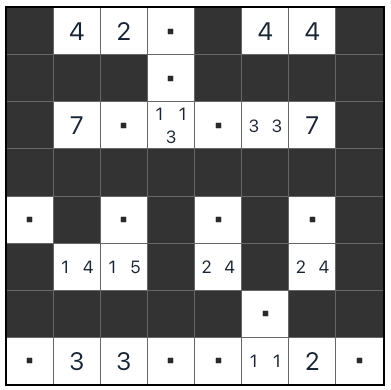Diagonal Consecutive Sudoku Hard
Like this puzzle!
4
7
2
5
2
5
1
9
9
6
2
7
2
3
6
1
4
5
6
9
3
7
6
8
5
1
2
3
4
5
6
7
8
9
?
~
123
1
2
3
Helping solve
Undo
Redo
Delete
0
Hint
Latest score list for #qmkv9
pr
premium a second ago
17'59''
ov
overtons 5 minutes ago
19'17''
gu
guest 23 minutes ago
9'26''
Ha
Hail car 26 minutes ago
12'32''
Do
Donate an hour ago
17'5''
so
social 31 minutes ago
6'13''
fi
finance 37 minutes ago
14'10''
an
anonymous 54 minutes ago
6'24''
Li
Liam an hour ago
14'5''
li
lightroom 2 hours ago
10'34''
Latest score list for Diagonal Consecutive Sudoku
ma
masters solved puzzle No#xgjx1;
15'26''
an
anonymous solved puzzle No#j8k19;
17'9''
Pr
Prestashop solved puzzle No#gex1v;
18'54''
se
sell cash solved puzzle No#vrg7y;
10'24''
Li
Liam solved puzzle No#mj012;
13'17''
wa
warranty solved puzzle No#7j109;
10'58''
gu
guest solved puzzle No#vrg7y;
6'36''
Bi
Bitcoin solved puzzle No#294k8;
17'36''
an
anonymous solved puzzle No#mjxpr;
11'35''
li
lightroom solved puzzle No#pwmnr;
9'51''
How to play Diagonal Consecutive Sudoku
Diagonal Consecutive Sudoku Rules
Consecutive Sudoku: Standard Sudoku rules apply (1-9 in each row, column, and box) with the added twist of bars between some squares. These bars mean the numbers in those squares must be consecutive (differ by 1).
Diagonal Consecutive Sudoku Additional Rules:
-
Diagonal Sudoku Rule: Sudoku main diagonals also contain the digits 1 through 9.
Read more: Diagonal Consecutive Sudoku rule & tips
Using the Markings:
Pay close attention to the consecutive markers while placing numbers. If two cells are connected by a bar, the numbers you place in them must differ by exactly 1.
Conversely, if there's no marking between two cells, the numbers in those cells cannot be consecutive.
Diagonal Consecutive Sudoku = Diagonal Sudoku + Consecutive Sudoku.
Privacy Policy Copyright Gridpuzzle © 2024



























